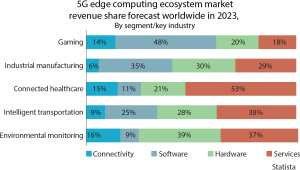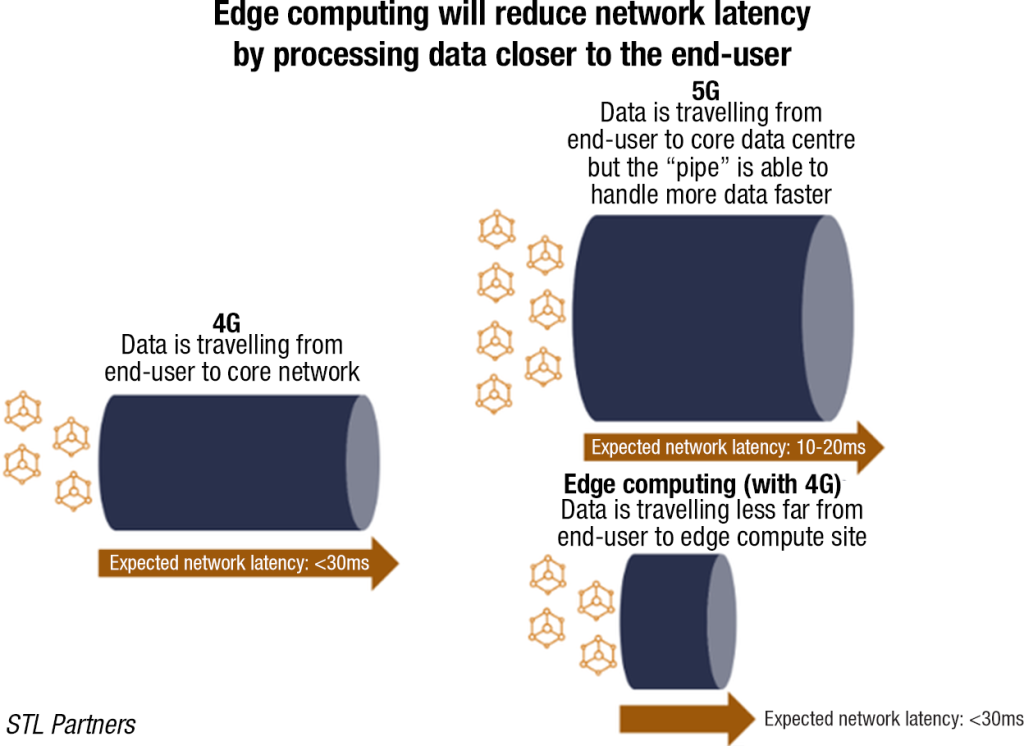CT Stories
5G and multi-access edge computing – A powerful combination

A next-generation network isn’t just about speed. It’s about reimagining what’s possible. MEC and 5G can help innovate and transform.
With brands undergoing a digital transformation, businesses are well-poised to take advantage of next-generation networks, propelled by the powerful combination of 5G and multi-access edge computing. This revolutionary network architecture is creating a plethora of opportunities to enhance digital experiences, support data security, and enable continuous operations in every industry. Through its increased performance, 5G can enhance edge-computing applications by reducing latency, bettering application response times, and improving the ability of enterprises to collect and process data.
5G and edge computing are two inextricably linked technologies. They are both poised to significantly improve the performance of applications and enable huge amounts of data to be processed in real time. 5G increases speeds by up to ten times that of 4G, whereas multi-access edge computing reduces latency by bringing compute capabilities into the network, closer to the end user. Data is processed and stored at the network’s edge, not at some distant data center. Multi-access edge compute (MEC) provides both an IT service environment and cloud computing capabilities to enable real-time enterprise.
By 2025, 75 percent of enterprise data will be processed at the edge, thanks to the increasing adoption of 5G technology, says Gartner. 5G enables an era of user-centric network by bringing in the concept of network slicing and composable networking. This has caused a fundamental shift from network aware application design to application-centric network provisioning.
As applications move from core to the edge of the network, 5G and MEC can be a force multiplier for innovation. Businesses will benefit from this combination:
- Virtualisation from the core to the edge. Apart from the core of any network, the radio access network (RAN) edge can also be virtualized, making edge-on-demand possible.
- Extensive reach. MEC is all about extensive reach, and there is a huge potential for Tier-II, Tier—III, and Tier-IV cities in India to benefit from this network.
- Performance and reliability. MEC is built right to support even the most demanding of applications and use cases.
Edge computing addresses the principal network limitations, bandwidth, latency, and congestion or reliability. To elaborate:
- Bandwidth is the amount of data, which a network can carry over time, usually expressed in bits per second. All networks have a limited bandwidth, and the limits are more severe for wireless communication. This means that there is a finite limit to the amount of data – or the number of devices – that can communicate data across the network. Although it is possible to increase network bandwidth to accommodate more devices and data, the cost can be significant. There are still (higher) finite limits and it does not solve other problems.
- Latency is the time needed to send data between two points on a network. Although communication ideally takes place at the speed of light, large physical distances coupled with network congestion or outages can delay data movement across the network. This delays any analytics and decision-making processes, and reduces the ability for a system to respond in real time. It even cost lives in the autonomous vehicle example.

Congestion. The internet is basically a global network of networks. Although it has evolved to offer good general-purpose data exchanges for most everyday computing tasks – such as file exchanges or basic streaming – the volume of data involved with tens of billions of devices can overwhelm the internet, causing high levels of congestion and forcing time-consuming data retransmissions. In other cases, network outages can exacerbate congestion and even sever communication to some internet users entirely – making the Internet of Things useless during outages.
The new 5G core, as defined by 3GPP, utilizes cloud-aligned, service-based architecture (SBA) that spans across all 5G functions and interactions including authentication, security, session management, and aggregation of traffic from end devices. 3GPP’s first three 5G specifications, Release 15, Release 16, and Release 17 are now almost complete. 3GPP has already started working on the next set of releases that will bring 5G-Advanced, scheduled from 2024 onward.
5G comes with a set of new features to satisfy the demand of data-intensive applications – millimeter-wave frequencies, massive antenna arrays, beamforming, dense cells, and so forth. Beamforming helps create more reliable connectivity by allowing a transmitter to focus the transmission in a specific direction toward a mobile device, vehicle, or IoT device. 5G networks supporting beamforming are three times more energy-efficient than 4G networks, based on the defined energy-efficiency parameter
The migration to edge computing for many operators forms part of this wider 5G network infrastructure upgrade that is underway. Many components need to come together in unison, and this includes upgrades to RAN and core components, upgrades to the underlying optical transport network, new edge-compute resources, and availability of physical locations with enough free space and power to house the additional equipment.
One of the biggest challenges for network operators as they roll out 5G upgrades is the availability of space and power. But in many cases, we find there is also a real challenge just to add new DWDM optical networking hardware into existing networks due to space and/or power limitations. This is especially the case the closer the upgrade is to the edge of the network.
For example, many access nodes are nearly full, so the DWDM upgrade needs to have minimal or zero impact on space and power requirements. Deploying auto-tuneable DWDM pluggable optics directly into the third-party host equipment is one of the tools available to address this.
Some other cases are even more challenging. How do operators scale their networks to the higher capacity required for 5G and add new edge compute resources economically if those locations are nearly full already? They will need to upgrade the network and remove additional hardware to free up space and power for the new edge-compute resources. New optical networking architectures, like the Open XR Forum’s point-to-multipoint XR optics, are becoming available and can address this challenge by removing the need for intermediate aggregation and switching devices and offering the potential for mounting DWDM transceivers directly into edge-compute hardware. But until these are actively rolled out, some of these more challenging network transitions will be a struggle to achieve.
Many RAN vendors offer virtualized DU/CU and core software via the cloud operators’ data center infrastructure. Optical networks are being upgraded to support these new capabilities, and new innovations offer the potential to optimize this further and really address the challenge of edge compute in space and power-restricted environments. It will happen. We will get there, wherever there is. But it will take a little time.
How edge computing will benefit from 5G technology. As 5G gets closer to its widespread rollout and more countries work to introduce it, people are increasingly abuzz about what changes it will bring to the tech world.

Here are some specific ways it will likely impact edge computing:
5G will help edge computing grow. Analysts believe that the arrival of 5G will result in a time when edge computing is essential rather than optional. The 5G network’s speed should be 10 times faster than what the 4G network allows. That improvement opens possibilities for far-away sensors to instantly give updates about the connected devices. That increase in real-time processing will require new equipment with enhanced capabilities.
This will also raise the demand for edge computing since that method processes data at the borders of a network rather than transferring the data a significant distance first.
5G can help thin apps thrive. Because of 5G’s low latency, thin apps could refine the mobile medical industry, the way we engage with transportation and smart cities, and even how we interact with documents. So you might monitor your fitness goals, beat traffic to make your restaurant reservation, and translate a foreign menu – all in real time.
Edge networks will become more specialized and complex. 5G networks are also set to become more complicated than they are now. Investments to make that happen are already underway, thereby increasing the relevance of edge networks in the world’s future. Edge networks will largely depend on device functionality, with the networks’ characteristics matched to the gadgets that need them.
An autonomous car would need extremely speedy edge networks, primarily because characteristics in a car’s environment could change by the second. Processing data at the edge on the 5G network allows saving power and infrastructure. But, the location of the edge device depends on the application.
5G, especially when combined with MEC, can fundamentally change robotics. With massive and low-latency connectivity, robots can offload their computing and intelligence to edge servers that have much greater capacity and scalability, easier maintenance, and better upgradability. Robots can become lighter, cheaper, and have more intelligence. Their users will have more choices for hardware, software, and add-on functionality.
Business leaders must be mindful that there are still a lot of specifics to work out regarding the 5G network and edge computing. Thus, it is too early to know for sure about the specific ways that edge networks will get more complicated, but evidence suggests it will happen soon and be device-specific.
Moreover, because the edge networks will depend on the devices that use them, variations will exist, concerning whether network operators would own them, buy, or lease them through service models or rely on established cloud providers to help.
Edge networks will help increase 5G performance on a per-user basis. Beamforming technology allows a signal to position itself in the direction of the device that receives it. This advantage gives stronger, faster signals. In this case, software electronically directs the 5G signal toward a user’s handset to increase efficiency and signal quality. The accompanying edge-computing platform is a fully virtualized, end-to-end solution that supports using this kind of 5G beamforming technology for the first time in a live environment.

The 5G network will undoubtedly pave the way for the introduction of new technologies – including those not even conceived yet. A lot of the new technologies will be IoT-oriented since those devices need low latency to function properly.
Together, 5G and edge computing are enabling new innovations, which improve both efficiency and customer experience. The barrier to entry is low and once 5G and edge computing are in place, businesses can start experimenting immediately with new applications or improvements to existing ones.
Edge network devices must receive tighter security monitoring. One of the things that cyber security experts often bring up about edge networks is that they can cause increased security risks due to the increased number of devices on the network that are gathering data. For example, an edge device deployed in a remote location may not have people checking it regularly for security vulnerabilities or keeping its software updated.
Microcontrollers, sensors, and other devices that live at the edge of the internet must be protected against cyber-attacks and intrusions just as much as the chips in data centers, network routers, and PCs. But securing those edge devices presents a swath of unique challenges, including the cost and availability of technology resources, as well as varying levels of motivation to solve these problems by both vendors and end-users.
Many devices manufacturers are already thinking ahead and integrating better cyber-security into their gadgets. Doing that could help the 5G network and edge devices benefit each other without causing security threats.
The coming together of 5G and edge computing is not just a change in IT infrastructure or change in the way data is stored, transmitted, or analyzed in organizations. It is in fact a paradigm shift in business, and places real-time data analysis at the center of the enterprise for increased productivity and performance.
The message is loud and clear for both enterprises and telcos – a business-as-usual approach will not work in this digitized world, and everyone needs to gear up for a brave new world that is emerging on the horizon; a world in which data will be continuous as well as separate, a part of the cloud, as well as sit on the edge. Telecom infrastructure needs to enable both cloud as well as edge to enable and to value-add to the businesses of tomorrow. And this is the true power of 5G!













You must be logged in to post a comment Login